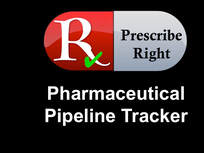|
Regulatory Update
The FDA accepted the BLA for Revance’s daxibotulinumtoxinA for the treatment of moderate to severe glabellar lines and set a PDUFA date of 11/25/2020. Mesoblast completed a rolling BLA for remestemcel-L in February 2020 for the treatment of pediatric steroid resistant graft versus host disease. CorMedix initiated a rolling NDA for taurolidine in February 2020. The EMA accepted the MAA for GlaxoSmithKline’s belantamab mafodotin to treat multiple myeloma. Announced Research Updates Roche announced that in the 12-month, 180 patient, Phase III SUNFISH trial, treatment with risdiplam increased the Motor Function Measure 32 (MFM32) score by 1.59 points compared to placebo in patients with Type 2 or 3 spinal muscular atrophy. Lilly announced that in the 16-week, Phase III, BREEZE-AD5 trial, 29.5% of patients treated with baricitinib 2 mg achieved a 75% or greater change from baseline in their Eczema Area and Severity Index (EASI-75) compared to 8.2% with placebo in patients with moderate to severe atopic dermatitis. Improvement with a 1 mg dose of baricitinib did not reach significance. Biohaven Pharmaceutical announced that in an 8-week, 402 patient, Phase III trial, treatment with troriluzole was no different that placebo in improving the Hamilton Anxiety Rating Scale (HAM-A) in patients with Generalized Anxiety Disorder (GAD). Published Research Updates In the 34-week, 301 patient, Phase III REAL 1 trial, treatment with somapacitan reduced the truncal fat percentage an additional 1.53% compared to placebo in adults with growth hormone deficiency. In a 52-week, open-label extension of REAL 1, truncal fat reduction was maintained with somapacitan and growth hormone at 86 weeks. In a 6-month, 54 patient, Phase III, open label trial, 70.4% of patients treated with remestemcel-L had an overall response to the treatment at day 28 compared to a historical rate of around 45% in children with acute graft-versus-host disease that was refractory to steroids. At 180 days, the overall survival rate was 78.9% in responders at day 28 compared to 47.1% in non-responders. In the Phase Ib, open-label TATTON trial, treatment with osimertinib plus savolitinib resulted in 79/138 patients with a mixed treatment history achieving an objective partial response and 23/42 patients that had not previously received a third-generation EGFR TKI and were Thr790Met negative achieving an objective partial response in patients with locally advanced or metastatic, MET-amplified, EGFR mutation-positive non-small-cell lung cancer, who had progressed on EGFR TKIs. In a 112 patient Phase I, open label trial, treatment with enfortumab vedotin resulted in a 43% objective response rate in patients with Nectin-4-expressing urothelial carcinoma who progressed on at least 1 prior chemotherapy regimen and/or anti-PD-(L)1 therapy. In the 462 patient, Phase III ADAPT trail, treatment with Rocapuldencel-T in combination with sunitinib did not improve overall survival compared to sunitinib monotherapy in patients with metastatic clear cell renal cell carcinoma. In a 6-month, 73 patient, Phase II trial, 28% of patients treated with rindopepimut plus bevacizumab achieved progression-free survival at 6-months compared to 16% with bevacizumab in patients with recurrent EGFRvIII-positive glioblastoma. In the 48-week, 203 patient, Phase IIb, BE ACTIVE trial, ACR50 was achieved in 26.8% of patients treated with 16 mg of bimekizumab, 41.5% with 160 mg, 46.3% with 160 mg after a 320-mg loading dose, and 24.4% who received 320 mg compared to 7.1% with placebo in patients with psoriatic arthritis. Patients from the 16 mg and placebo groups were then randomized to one of the higher doses for 36 weeks. At 48 weeks, ACR50 had been achieved by 55% with 160mg, 57% with 160 mg after a 320 mg loading dose and 63% with the 320 mg dose with improvements seen in the 16 mg and placebo patients randomized to higher doses of bimekizumab. A published BioMarin funded cost-effectiveness analysis found the lifetime cost to treat hemophilia A as $23.5 million with prophylactic factor VIII and $16.7 million with valoctocogene roxaparvovec for a savings of $6.8 million per patient. ICER is currently working on an analysis of valoctocogene roxaparvovec compared to emicizumab and factor VIII. SPK-8011, another hemophilia gene therapy and fitusiran, an RNA interference drug for the treatment of hemophilia A and B were not included in the current scoping document draft. Comments are closed.
|
Stay informed, subscribe to the
Prescribe Right Pharmaceutical Pipeline Tracker Latest Tweets from Prescribe Right
Archives
July 2023
|
Services |
Company |
Support |
© COPYRIGHT 2015. ALL RIGHTS RESERVED.
|


 RSS Feed
RSS Feed